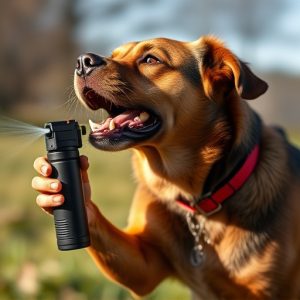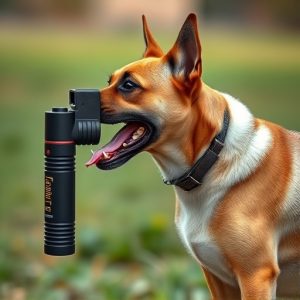Runner’s Safety: Dog Deterrent Sprays and Their Active Ingredients
Dog deterrent sprays protect runners from aggressive canines during outdoor activities, using active…….
Dog deterrent sprays protect runners from aggressive canines during outdoor activities, using active ingredients like capsaicin (chili pepper derivative) and pheromones to trigger non-lethal reactions in dogs. Effective formulas stimulate canine senses, deterring them without harm. Key active ingredients include capsaicin and citric acid, which cause discomfort and encourage retreat. For optimal use, identify dog-frequented areas, spray strategically along fences with short bursts, follow manufacturer instructions regarding application frequency and quantity, and take safety precautions.
Runners often face unexpected encounters with dogs while on their trails, which can disrupt their workouts and pose safety risks. This article delves into the world of dog deterrent sprays as a potential solution for runners’ defense. We explore the science behind these repellents, focusing on key active ingredients that have proven effective in scaring away dogs. By understanding the right application techniques, runners can enhance their outdoor experience while ensuring optimal results.
- Understanding Dog Deterrent Sprays: Their Role in Runner's Safety
- The Science Behind Effective Dog Repellent Formulas
- Key Active Ingredients and Their Efficacy in Scaring Dogs
- Application Techniques and Precautions for Optimal Results
Understanding Dog Deterrent Sprays: Their Role in Runner's Safety
Dog deterrent sprays are designed to protect runners from aggressive canine encounters during outdoor activities. These innovative products play a crucial role in ensuring runner safety by offering a non-lethal means to deter dogs, especially those known for their territorial or protective behavior. The active ingredients in these repellents are key to understanding their effectiveness. Common components include capsaicin, often derived from chili peppers, and specific pheromones that mimic natural dog alarm signals.
When a dog detects these active ingredients through its sensitive nose, it triggers an immediate reaction, usually escaping or displaying defensive behavior without causing harm to the runner. This is particularly beneficial in areas where dogs roam freely, such as parks and trails, allowing runners to maintain their pace and safety while enjoying nature.
The Science Behind Effective Dog Repellent Formulas
The effectiveness of dog deterrent sprays lies in their carefully crafted formulas, which often include specific active ingredients designed to stimulate a canine’s senses. These active ingredients can vary from natural substances like capsaicin (the active component in chili peppers) to synthetic chemicals that mimic existing sensory triggers. When applied correctly, these sprays create an unpleasant experience for dogs, discouraging them from approaching or remaining in the treated area.
Researchers and manufacturers thoroughly study animal behavior and physiology to identify the right balance of components that will be effective yet safe. The active ingredients in dog repellent spray are chosen based on their ability to disrupt a dog’s sense of smell or taste, often targeting their highly sensitive olfactory systems. By understanding how dogs perceive their environment, formulators can create sprays that effectively deter without causing harm, making them popular choices for runners seeking to protect themselves while out on their trails.
Key Active Ingredients and Their Efficacy in Scaring Dogs
The effectiveness of a dog deterrent spray largely depends on its active ingredients and how they interact with canine senses. Key active ingredients commonly found in these sprays include capsaicin, a natural compound derived from chili peppers, and citric acid, often paired with other fragrances like lemon or pepper. These substances stimulate the dog’s olfactory and tactile systems, causing discomfort and fear. Capsaicin, in particular, mimics the body’s natural pain response, leading to quick avoidance behavior.
While these active ingredients may not directly harm dogs, they serve as powerful psychological deterrents. The sudden release of strong odors and the sensation of irritation encourage dogs to retreat, making them less likely to approach areas treated with the spray. As such, understanding the role of these active ingredients is crucial when selecting a dog deterrent spray to ensure maximum efficacy in keeping both runners and their four-legged companions safe during outdoor activities.
Application Techniques and Precautions for Optimal Results
For optimal results with runner’s defense dog deterrent spray, understanding application techniques and precautions is key. Begin by identifying specific areas where dogs typically congregate or enter, such as parks, trails, or backyards. Spraying along fences, trees, and other obstacles can create a visual and scent barrier that discourages dogs from approaching. The active ingredients in the repellent spray play a crucial role; they should include capsaicin, citronella, or other natural compounds known for their effectiveness in repelling canines.
Ensure even coverage by spraying in short bursts, allowing the mist to dry before applying additional layers. It’s important to follow the manufacturer’s instructions regarding frequency and quantity. Safety precautions are also vital: wear protective gear during application, keep the spray out of reach from children and pets, and avoid spraying near bodies of water or in strong winds to prevent inhalation hazards.
Dog deterrent sprays are a valuable tool for runners seeking to protect themselves from potential canine encounters. By understanding the science behind these formulations and choosing products with effective active ingredients, runners can enhance their safety while navigating through areas frequented by dogs. Proper application techniques and awareness of precautions ensure optimal results, allowing runners to enjoy their trails without unnecessary worry. The key lies in selecting a spray that suits individual needs and using it thoughtfully, making it a game-changer for outdoor enthusiasts concerned about dog interactions.


